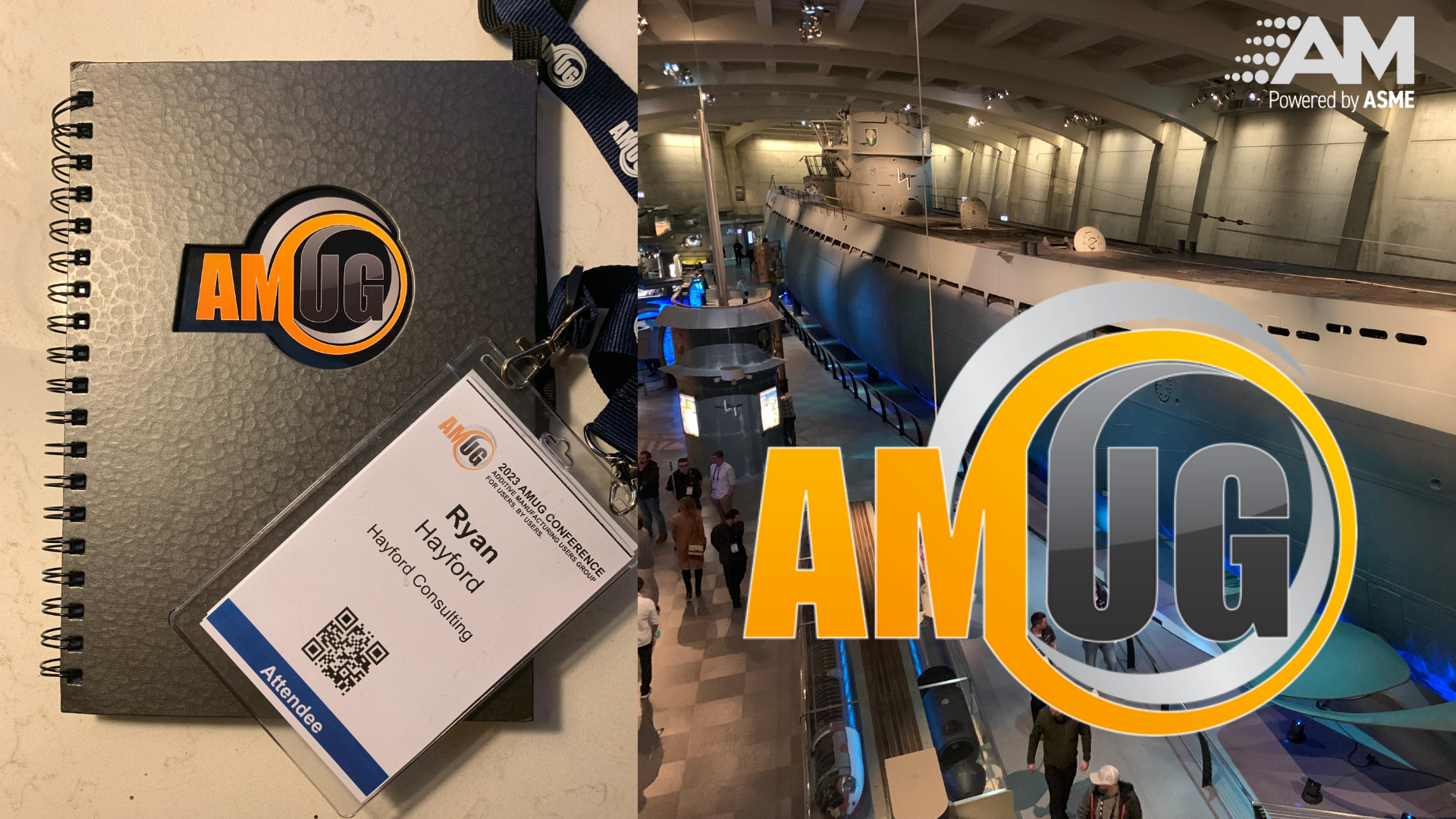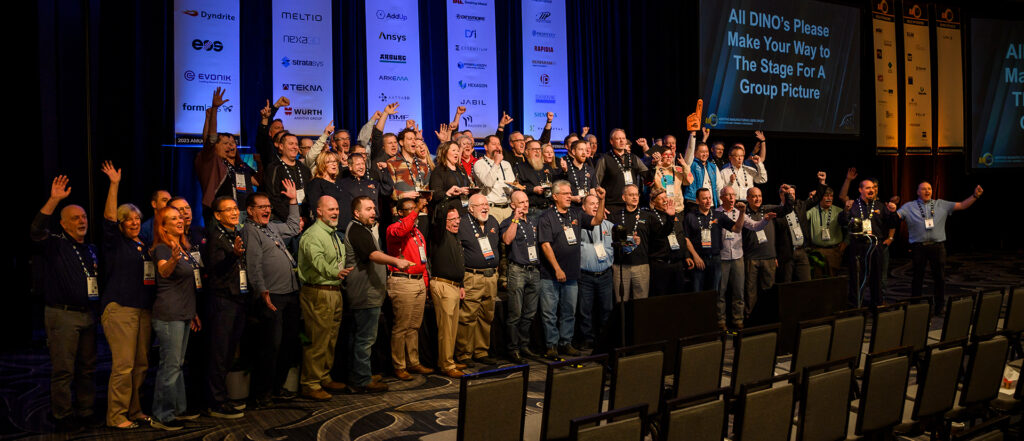
Ah, 720 Michigan Avenue. The ever-so-familiar Chicago Hilton hosted the 2023 Additive Manufacturing Users Group (AMUG) Conference. The intimate venue packed over 2,000 attendees for a week-long, highly technical conference, that once again, blew away expectations. During the five days of the event, thought leaders and experts shared information on new AM applications, standards, and ongoing projects across every industry imaginable.
As is always the case for the AMUG Conference, major manufacturers and prominent users openly shared their commitments to additive manufacturing and where their respective organizations expect to be in the next five-to-ten years. Not only is that incredibly insightful, it also justifies the continued focus on AM adoption for new applications, specifically production.
As an AMUG veteran, I approach the show differently each year and stay focused on my personal and professional goals. As a writer and a marketer, my first priority is to learn directly from the users about their successes, failures, challenges and progress in additive manufacturing. One question you’ll always hear me ask is, “What are you trying to accomplish during this conference?”

My second goal in 2023 was to dig deeper with many of the conference sponsors and to identify the companies and leaders who are genuinely (and authentically) telling their stories to the market. That’s always a tricky one, but I’ve learned to sift through marketing speak and do my best to take my questioning one step further.
Finally, and maybe most importantly, I never underestimate the value of networking during the AMUG Conference, especially with new users and entrants into the industry. Opportunity knocks at every impromptu discussion during breakfast, within the hotel hallways and with each bus ride. While it can be a grueling five-day sprint, it is worth it.
After several days of reflection, I’m ready to share my takeaways from the 2023 AMUG Conference. There is a lot to unpack, so I’ll do my best to condense it into three sections, Technical Content Review, Networking and the Future of AMUG.
Technical Content Review
In my estimation, this was one of the most technically-strong AMUG Conferences that I have ever attended. The combination of user applications, informative panel discussions and industry-specific content was abundant and informative. A large percentage of presentations focused on the industry-driven standardization of additive manufacturing, most notably automotive.
I was personally looking forward to Maximilian Binder’s, Additive Manufacturing in the Automotive Industry – Potentials, Requirements and Current Barriers, and it did not disappoint. BMW’s approach to establishing standards is not only pragmatic, but highly inclusive of machine, material and part suppliers to streamline the process and get more parts approved faster for production purposes. From the development of foundry specifications to quality assurance procedures and delivery methods, BMW seems to have a strong mission to increase its AM production. Without sharing too much information, BMW expects to double the number of 3D-printed parts on a vehicle within the next few years (mostly metal). Of course, the major barrier is still cost per part, which Binder addressed directly.
Presenting to a packed house, Victoria Sears from the Mayo Clinic delivered an excellent application review of 3D printing in the healthcare market. This included medical device developments, surgery preparation guides, patient communication tools and other use cases that they are involved with. Sears made it clear that 3D printing has proven to positively impact surgical and clinical practices, resulting in a surge of point-of-care (POC) manufacturing within hospitals throughout the country. The Anatomic Modeling Unit (AMU) at Mayo Clinic integrates 30-plus 3D printers, representing several different technologies, to create patient-specific models and surgical tools. What was labeled as a beginner class felt much more than that.
Following the Mayo Clinic presentation were Kirk Gronda, Joe Copley, and Caroline Alting, representing Cirtec Medical and Restor3D. Their presentation focused on intelligent medical device implants and the value of titanium additive manufacturing. I caught up with Caroline Alting (Biomedical Engineering, Georgia Tech) after the conference and asked her which presentation stood out to her and why it was signifcant.
“Matthew Shomper’s presentation on flexible titanium, nTopology modeling, and his work with a geometric structure for enhanced tissue growth is very similar to what we do,” Alting stated “Matthew’s inspiration for modeling and printing flexible geometries comes from the mantis shrimp (psst… everyone should look up the mantis shrimp), which emphasized how nature can be a source of inspiration in research and technical fields. His presentation also gave me many new ideas for my own project.”
I have since looked up the mantis shrimp and agree. Biomimicry is a fascinating field and an excellent application of additive manufacturing for material combinations and unique structures.
Networking
Another AMUG, another jam-packed conference that begins at 8 a.m. every day and could take you well past midnight most evenings. For those of you that have previously attended AMUG, you know that networking is a key component of the event. For those who are considering attending in the future, it’s important to know that the conference organizers strategically provide every opportunity for users to meet and connect with industry peers, thought leaders and other professionals throughout the five-day experience. The Chicago Hilton is conveniently equipped with multiple meeting spaces, so it’s up to you if it’s coffee at Starbucks or a pint at Kitty O’Sheas. If you want my friendly advice, stay hydrated.
According to Derek Ellis, Director of the AMUG New Member Committee, there were approximately 650 first-time attendees, accounting for almost one-third of the total audience. The highest percentage of first-timers had less than five years of AM experience but there were several conference newbies with 10-plus years in the AM industry. The combination of varying levels of experience with natural networking opportunities typically leads to many informative and collaborative conversations.
I caught up with first-time attendee, Jackson Moreland (3YourMind) to learn about his perspective on networking at AMUG.
“Whether it was on the exhibition floor, during the mixer events, or even on the bus, it felt like I was making valuable connections everywhere,” said Moreland “It seems to me like AMUG hits a sweet spot in size — It’s large enough so that you’ll constantly be meeting new people but exclusive enough that nearly every hand you shake is valuable.”
Whether it’s the intimate hotel setting, random lunch seat assignments or libation-filled extracurricular activities, it’s clear that AMUG builds a safe and comfortable setting for everyone to speak freely and enjoy themselves. While engineers are typically more reserved in nature, Derek Ellis and the AMUG New Member Committee felt that it was their responsibility to provide a strong networking experience.
“Our goal is to be inclusive,” Ellis stated. “Many first-timers can be hesitant or standoff-ish so we are committed to actively engaging them. It’s not uncommon that a prominent CEO, Material Science Ph.D. and a young, aspiring engineer are sharing a laugh or solving the world’s problems during a 15-minute break.”
Ellis isn’t wrong and this year’s surprise trip to the Chicago Science Museum was another resounding success for networking and attendee-enjoyment. The larger than life U-505 exhibit was exceptionally impressive and garnered the attention of all.
The Future of AMUG
As previously mentioned, one-third of the total audience was comprised of first-time attendees. In order for this industry to grow and learn as a community, it’s important to bring in new faces, ideas and incentivize cross-industry collaboration. But beyond that, AMUG is beginning to become a singular source of honest feedback, within a relatively young industry that is constantly chasing conventional manufacturing, hoping to revolutonize it. It’s clear that our industry is not there yet, but after speaking with several OEMs, contract manufacturers, material providers, and standards organizations, it’s my belief that we are progressing in the right direction.
Additive OEMs are chasing production volumes with their respective technologies and are in a relentless pursuit of adoption. Material developers are constantly filling that demand and simultaneously researching new applications and evaluating market opportunities for new materials. Software providers are developing new tools to support that growth and the standards organizations are collaborating to advance the qualification of AM parts for production. What does this competitive and cooperative environment mean for the end user?
First, the users are in a very unique power position to demand deeper relationships with the OEMs and co-develop technology roadmaps. Second, there is a natural hesitation to adopt new technologies due to obsolescence so I expect users to continue outsourcing to contract manufacturers and really strengthening those relationships. Finally, the impressive collection of experience and expertise that exists in the additive manufacturing users group may be leveraged further and beyond its original mission.

AMUG will always be a beacon of technical excellence that gathers the brightest minds in the AM industry. While this mission will never change, nor the passion that resides within this network to advance additive manufacturing, I wonder if it’s time for AMUG to be something more. Is a singular event enough? What if there is too much content? How do we practically address adoption barriers and leverage the vast collection of expertise?
It’s serendipitous that Relativity Space launched its first-ever 3D-printed rocket the same week as the AMUG Conference. Is this a coincidence? Or is it a sign that AMUG too may be prepping its own launch program? The future of AMUG is expansive, and the next phase of user collaboration and industry advancement will likely be led by the movers and shakers who attend this conference. Personally, I’m looking forward to it.
More AMUG 2023: Additive Manufacturing Users Group Presents DINO Awards to Ten Members


